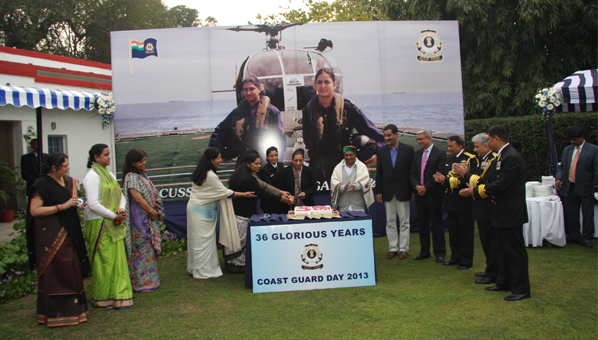|
Since its inception, the Service has grown into
a multi-faceted and vibrant force, maintaining
round the clock vigil in the Maritime Zones of
India, by deploying its multi-role ships and aircraft.
Beginning with a modest inventory of two frigates
seconded from the Indian Navy and five boats from
the Customs Department, the Service now has attained
a force level of 77 ships and 56 aircraft. Significantly,
during the past year, 1 Pollution Control Vessel,
6 Inshore Patrol Vessels, 4 Air Cushion Vessels
and 2 Interceptor Boats have been inducted.
In addition to the establishment of a Regional
Headquarter (NE) and activation of 8 CG Stations,
activation/commissioning of 3 CG Stations has
been planned in early 2013.
Defence Minister AK Antony, who attended a ceremony
to mark the event, the strength of ICG would double
by 2018. ICG Director General Vice Admiral MP
Muralidharan hosted the event in New Delhi.
The Indian Coast Guard indeed is on the path
of rapid expansion, with a large number of state-of-the-art
ships, boats and aircraft under construction at
various shipyards/ Public Sector units (PSUs),
and a Coast Guard Academy being established in
the near future.
The Coast Guard organizational structure will
have five Regional Headquarters, 12 District Headquarters,
42 Stations and 15 Air Units functioning all along
the Indian coast.

On the manpower front, the Service has initiated
several measures to augment its manpower viz introduction
of short service appointment (SSA) for women officers
in General Duty and General Duty (CPL holders)
branches, departmental promotions of outstanding
Subordinate Officers and conduct of special recruitments
drives.
An average of 20 ships and 8-10 aircraft are
tasked daily, to keep the vast Exclusive Economic
Zone (EEZ) and coastline under constant surveillance.
The ICG has also set up the Coastal Surveillance
Network (CSN), that comprise a network of coastal
surveillance radars and electro optic sensors
at 46 remote sites, including 36 on the main land,
6 in Lakshadweep Islands and 4 in Andaman and
Nicobar Islands.
Regular community interaction programmes are
being conducted by Indian Coast Guard in the fishing
villages all along the coast .These programmes
are aimed at sensitizing the fishing community
on the prevailing security situation and to develop
them to be the ‘eyes and ears’ for intelligence
gathering. During the past year, ICG has already
conducted 20 coastal security exercises and 21
coastal security operations.
ICG undertakes Maritime Search and Rescue operations
round the clock. Untiring efforts under difficult
conditions have resulted in saving of 204 lives
in the last year. A total of 30 medical evacuations
at sea were also undertaken by the ICG during
this period.
ICG has carved a niche for itself at the International
level and is today recognized as the leading Coast
Guard in the region.
Institutionalized visits as per the Memorandums
of Cooperation/Understanding are being conducted
regularly. The 12th Indo-Japan Coast Guard High
Level Meeting was held on 21-24 Jan 13 in Tokyo.
The 8th Heads of Asian Coast Guard Meeting was
held at New Delhi on 1-4 Oct 2012, which was significant,
since this meeting was held for the first time
in India. In addition, the Indo-Pak Joint Working
Group Meeting was at New Delhi held on 11-14 Jul
12, for the first time.
The Indian Coast Guard has been expanding in
both capacity and capability. State-of-the-art
ships and aircraft manned by competent and professional
officers and men take pride in serving the nation
and protecting India’s maritime domain.
The theme of the Indian Coast Guard for the
year 2013 is ‘Focused on Maritime Safety
and Security’, which aptly reflects the commitment
and resolve of the service, and is in tune with
its motto ‘Vayam Rakshamah’ meaning
‘We Protect’.
|